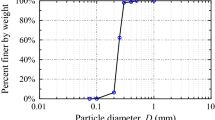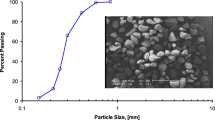Abstract
Liquefaction-induced ground deformation is a major cause of structural damage during earthquakes. However, a better understanding of seismic liquefaction is needed to improve earthquake hazard analyses and mitigate structural damage. In this paper, a dynamic triaxial test apparatus was employed to investigate the fluidic characteristics of post-liquefaction sand. The specimens were vibrated to the point of liquefaction by dynamic loading, and then the liquefied sand was further sheared by triaxial compression in an undrained manner. It was found that a non-Newtonian fluid model can accurately describe the shear stress and the shear strain rate of post-liquefaction sand during undrained triaxial compression. The apparent viscosity, a major parameter in a constitutive model of a non-Newtonian fluid, decreases with an increase in the shear strain rate.







Similar content being viewed by others
References
Astarita G, Marucci G (1975) Principles of non-Newtonian fluid mechanics. J Appl Mech 42(3):750
Aydan O (1995) Mechanical and numerical modeling of lateral spreading of liquefied soil. In: Proceedings of first international conference on earthquake geotechnical engineering, Tokyo, Japan, pp 881–886
Finn WDL (2000) Post liquefaction flow deformations. In: Pak RYS, Yamamura J (eds) Soil dynamics and liquefaction, ASCE Geotechnical Special Publication No. 107, pp 108–122
Finn WDL, Yogendrakumar M, Ledbetter R, Yoshida N (1991) Analysis of liquefaction induced displacements. In: Proceedings of 7th international conference on computer methods and advances in geomechanics, Cairns, Australia, pp 913–921
Fu SC, Tatsuoka F (1984) Soil liquefaction during Haicheng and Tangshan earthquake in China; a review. Soils Found 24(4):11–29
GDS Instruments (2009) Entry level dynamic triaxial system (ELDYN). http://www.gdsinstruments.com/products/eldyn.htm. Accessed 28 Nov 2010
Gutiérrez M, Eddy M, Lumbantoruan PMH (2007) Probabilistic Shear strength criteria for post-liquefaction evaluation of cohesion-less soil deposits. Final technical report. USGS grant. Virginia Polytechnic Institute and State University, USA, p 82
Hadush S, Yashima A, Uzuoka R, Moriguchi S, Sawada K (2001) Liquefaction induced lateral spread analysis using the CIP method. Comput Geotech 28(8):549–574
Huang Y, Jiang XM (2010) Field-observed phenomena of seismic liquefaction and subsidence during the 2008 Wenchuan earthquake in China. Nat Hazards 54(3):839–850
Ishihara K (1993) Liquefaction and flow failure during earthquakes. Geotechnique 43(3):39–46
Ishihara K, Koga Y (1981) Case studies of liquefaction in the 1964 Niigata earthquake. Soils Found 21(3):33–52
Kanibir A, Ulusay R, Aydan Ö (2006) Assessment of liquefaction and lateral spreading on the shore of Lake Sapanca during the Kocaeli (Turkey) earthquake. Eng Geol 83(4):307–331
Matsuo O (1996) Damage to river dikes. Soils Found 36(1):235–240
Ministry of Water Resources of China (1999) Specification of soil test (SL237-1999). China Water Power Press, Beijing (in Chinese)
Seed HB (1987) Design problem in soil liquefaction. J Geotech Geoenviron Eng ASCE 113(8):827–845
Seed HB, Idriss IM (1971) Simplified procedure for evaluating soil liquefaction potential. J Soil Mech Found Div ASCE 97(9):1249–1273
Seed RB, Cetin K O, Moss RES, Kammerer AM, Wu J, Pestana JM, Riemer MF, Sancio RB, Bray JB, Kayen RE, Faris A (2003) Recent advances in soil liquefaction engineering: a unified and consistent framework. In: 26th annual ASCE Los Angeles geotechnical spring seminar, Keynote Presentation, California
Shivamoggi BK (1985) Theoretical fluid dynamics. Martinus Nijhoff Publishers, Dordrecht
Towhata I, Sassaki Y, Tokida K, Matsumoto H, Tamira Y, Yamada K (1992) Prediction of permanent displacement of liquefied ground by means of minimum energy principle. Soils Found 32(3):97–116
Uzuoka R, Yashima A, Kawakami T, Konrad JM (1998) Fluid dynamics based prediction of liquefaction induced lateral spreading. Comput Geotech 22(3–4):243–282
Youd TL, Idriss IM (2001) Liquefaction resistance of soils: summary report from the 1996 NCEER and 1998 NCEER/NSF workshops on evaluation of liquefaction resistance of soils. J Geotech Geoenviron Eng ASCE 127(4):297–313
Acknowledgments
This work was supported by the National Basic Research Program of China (973 Program, Grant No. 2012CB719803), the National Natural Science Foundation of China (Grant Nos. 41111130205 and 41072202), the Program for New Century Excellent Talents in University (Grant No. NCET-11-0382) and the Kwang-Hua Fund for College of Civil Engineering, Tongji University.
Author information
Authors and Affiliations
Corresponding author
Rights and permissions
About this article
Cite this article
Huang, Y., Zheng, H., Mao, W. et al. Triaxial tests on the fluidic behavior of post-liquefaction sand. Environ Earth Sci 67, 2325–2330 (2012). https://doi.org/10.1007/s12665-012-1679-y
Received:
Accepted:
Published:
Issue Date:
DOI: https://doi.org/10.1007/s12665-012-1679-y




